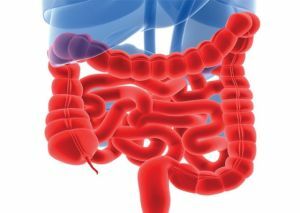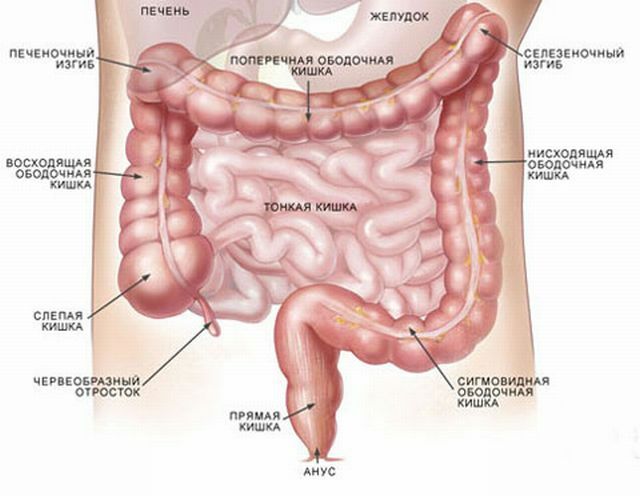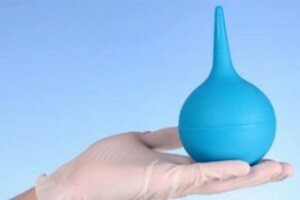 Proctosigmoiditis is the inflammatory process of the mucosa localized in the region of the sigmoid and rectum.
Proctosigmoiditis is the inflammatory process of the mucosa localized in the region of the sigmoid and rectum.
These are the final sections of the large intestine and gastrointestinal tract as a whole. In the sigmoid colon, water is absorbed and fecal matter is formed. The main purpose of the rectum is excretion of feces from the body.
Because of the proximity, the inflammatory process affects both parts of the intestine. The disease can flow in a chronic or acute form, depending on the cause of the onset, neglect and other factors.
Contents
- Causes and risk factors
- So different - so dangerous
- Symptoms of acute form of the disease
- Symptoms of the chronic form
- Diagnosis of the disease
- Treatment of the disease
- Local therapy
- Symptomatic treatment
- Sanatorium treatment
- Folk remedies
- Complications of the disease
- Prevention of the disease
Causes and factorsrisk of
The disease can be caused by chemical, mechanical or any other damage to the mucosa of the sigmoid and rectum.
The disease can be caused by various causes:
- infections that get into the rectum and sigmoid colon through the mouth, anus or other ways( dysentery, syphilis, cholera and so on);
- parasites;
- chronic diseases of the gastrointestinal tract( paraproctitis, gastritis);
- reception of antibiotics, in which there is a violation of the intestinal microflora;
- by the use of poisons or medications, which caused poisoning;
- dysbiosis.

In the risk zone are people who do not adhere to proper nutrition.
Drinking alcohol, as well as products that irritate the mucous( acute, fried foods) often leads to the development of an inflammatory process.
People with constipation are also at risk. Rough stools during passage through the intestine cause trauma to the mucosa.
Hemorrhoids, characterized by congestion of venous blood, also increase the risk of proctosigmoiditis, as blood circulation in the rectum is impaired.
Such different - such a dangerous
Depending on the characteristics of the inflammatory process, the following types of proctosigmoiditis are distinguished:
- Catarrhal .It is characterized by inflammation of the mucosa and changes in the intestinal microflora.
- Erosive .A distinctive feature is the formation of erosion on the surface of the mucosa.
- Ulcerative .The inflammatory process in a neglected form promotes the appearance of ulcers, which can damage the blood vessels and cause bleeding.
The disease is also divided into several types depending on the cause of the onset:
- infectious;
- stray;
- is congestive( constipation and hemorrhoids);
- ischemic( blood supply disorders in the elderly);
- toxic;
- alimentary( malnutrition and alcohol use);
- radiation( radiotherapy);
- is hematogenous( chronic illness or constant pressure from other internal organs).

The course of the disease can occur in acute or chronic form. An untreated or neglected proctosigmoiditis usually flows into a chronic form, which usually has prolonged remissions.
To cause an exacerbation of the disease may be malnutrition, drinking or taking certain medications, including antibiotics.
Symptoms of acute disease
The acute illness has the following symptoms:
- acute abdominal pain, often on the left side;
- frequent false defecation;
- constipation;
- diarrhea;
- feces with blood or mucus, less often pus;
- nausea;
- general weakness and malaise;
- bloating;
- sensation of the presence of a foreign body in the gut.
Sometimes the inflammatory process in the rectus and sigmoid colon is accompanied by an increase in temperature.
Symptoms of the chronic form
 The main symptoms in chronic proctosigmoiditis remain the same as in the acute form of the disease.
The main symptoms in chronic proctosigmoiditis remain the same as in the acute form of the disease.
Some symptoms become dull. For example, acute pain in the abdomen is replaced by a constant aching pain. In the anus can appear itching, burning or other unpleasant sensations.
In chronic form, there are also digestive disorders. There may be constipation, diarrhea, impurities in the stool, flatulence and other problems. The patient's weakness depends on his individual characteristics of the body.
Diagnosis of the disease
During the visit to the doctor the patient tells in detail about the complaints and symptoms. This helps the doctor to determine the cause of the disease or exacerbation, if it is a chronic form. The patient must necessarily donate blood, urine and feces to clinical studies.
But since this disease has similar symptoms to other bowel diseases, in particular to the rectum, instrumental examination using a rectoscope is used for correct diagnosis.
Rectoscopy helps to determine the area of inflammation localization, as well as related problems( hemorrhoids, fissures, fistulas, bleeding).
In rare cases( when the disease is started), if a suspected development of an oncological disease is suspected, a biopsy of the intestinal mucosa is performed.
Treatment of
The main goal of treating proctosigmoiditis is the removal of the inflammatory process in the rectum and sigmoid colon. 
In addition, the patient is prescribed drugs aimed at removing symptoms, restoring intestinal microflora.
A prerequisite for effective treatment is the observance of a strict diet, which removes the load on the intestines and prevents irritation of the mucosa. You may consume liquid or semi-liquid mashed food.
Vegetables and fruits must be amenable to temperature treatment.
Local therapy
Local treatment must be performed with suppositories with anti-inflammatory action. Also for the removal of inflammation, the doctor can prescribe microclysters with a decoction of chamomile or other herbs, collard, dogrose oil or sea buckthorn.
The purpose of the drugs directly depends on the cause of the disease. If the disease is caused by an infectious environment, a course of antibiotics must be prescribed.
Treatment of proctosigmoiditis is always accompanied by a disturbance of the microflora, so the patient needs to take biocultures to restore normal intestinal flora.
Symptomatic treatment of
Depending on the symptoms that accompany the disease, the patient is prescribed drugs:
- painkillers;
- antipyretic;
- for the resumption of the intestine( from bloating, constipation, nausea and so on).
If the disease is caused by parasites, the course of treatment necessarily includes anthelmintic medicines. When an allergic reaction occurs, you should use antihistamines.
Sanatorium treatment for
Patients suffering from chronic disease form are shown to have a sanatorium treatment. Patients are advised to drink alkaline mineral water, apply mud therapy and other physiotherapy procedures.
Folk remedies
 Alternative medicine also offers a number of prescriptions for the treatment of proctosigmoiditis at home.
Alternative medicine also offers a number of prescriptions for the treatment of proctosigmoiditis at home.
These are home ointments, suppositories, baths or microclysters based on herbs that have anti-inflammatory properties( chamomile, licorice root, calendula and so on).
But before using folk remedies, please consult with your doctor in order not to aggravate your condition.
Complications of the disease
Proctosigmoiditis in chronic form can have the following complications:
- anal fissures;

- hemorrhoids;
- formation of ulcers;
- bleeding;
- prolapse of the rectum.
If the inflammatory process affects pararectal tissue, paraproctitis develops.
An established form of the disease can lead to the appearance of peritonitis or perforation of the intestine. These diseases pose a danger to the life of the patient. In addition, the disease in chronic form increases the chance of developing bowel cancer.
Prevention of
disease Proctosigmoiditis, like any other disease, is easier to prevent than treat. To reduce the risk of developing the disease, you need:
- to observe the principles of proper nutrition;
- do not abuse food irritating mucous( hot, fried, smoked);
- to abandon bad habits, including alcohol;
- to reduce the consumption of coffee, strong tea and carbonated drinks;
- to lead an active lifestyle;
- treat all pathologies of the gastrointestinal tract and other internal organs.
If the disease is not triggered, it is easily treatable and does not pose a threat to the life of the patient. But with a neglected form, serious complications can develop, so if symptoms occur, visit a proctologist who will prescribe an effective treatment.
